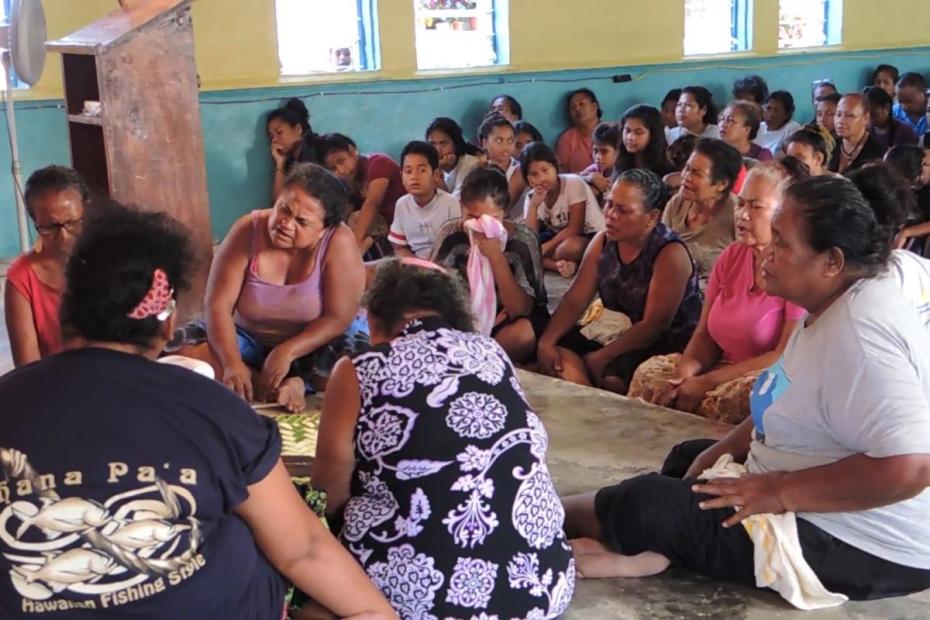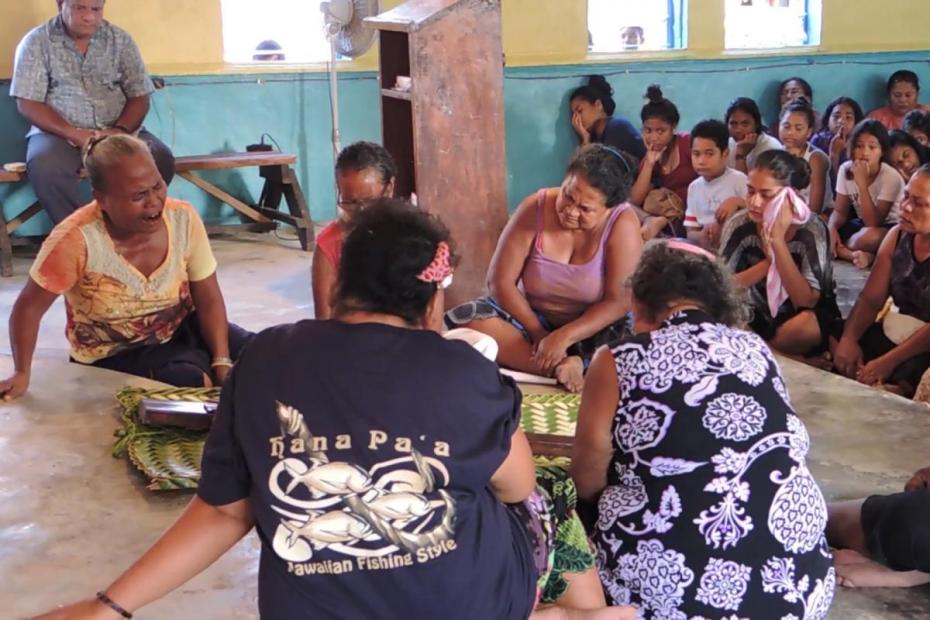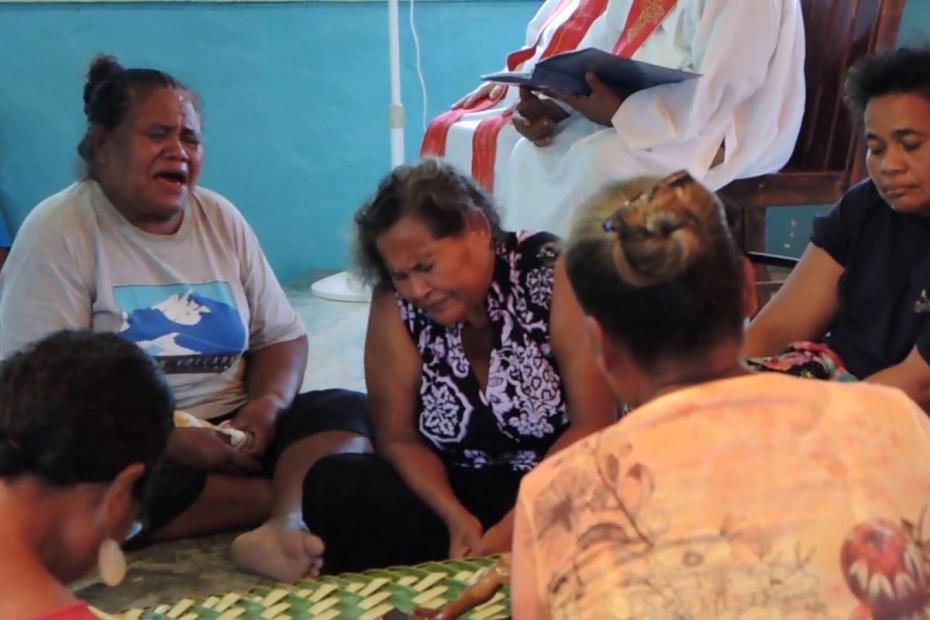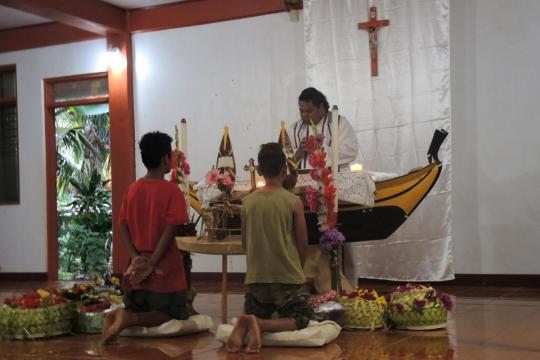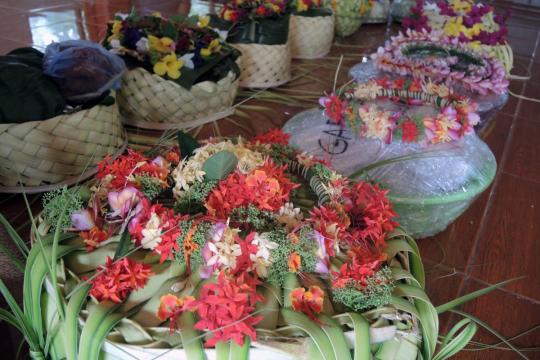One of the fundamental cultural qualities of Yapese culture, people often tell you, is that public display of emotion is disdained. Anger, even at a difficult situation, should not be expressed, publicly. Spouses shouldn’t show romantic affection in public. One Yapese woman summed it up, “You are taught not to be expressive, to keep to your own mind, not to show. That’s a reality deep in Yapese culture.”
It may be a surprise, then, that one of the most distinctive ritual experiences of Yapese Catholicism is a ritual wherein women sit around the image of Christ on the Cross and wail to recount and mourn Jesus’ Passion. Its expressive power is matched in few Catholic contexts.
The doloolow—Yapese for “wailing” or “lamentation”—builds on a cultural tradition that endures at funerals, where women traditionally wail in front of the body during the overnight vigil. Their wails tell the dead things that they wished they’d said or done more of while the person was alive. It is the one occasion when such expressiveness is not only allowed, but ritualized and prescribed. Traditionally it is a role exclusively for women, though men occasionally join the lamentation at funerals today.
The Good Friday doloolow was developed in the 1980s at the behest of a parish priest who witnessed the ritual at funerals. Several women of the parish worked with him to devise a text and set it to music.1
Though the words at funeral doloolow are “spontaneous” to the occasion, the Good Friday doloolow relies largely on a text, and adds a chorus between each verse. The St. Mary’s parish version has 10 verses, and a single musical setting, but in practice some people improvise. Interviewees were split over which form was more authentic for the occasion: following the original text, or improvising from the heart.
The text used at Saint Mary’s parish has been translated as follows:
chorus: My Jesus, My Jesus, My Jesus
I’m crying, crying for you, my Savior
How you have really cared for us and loved us
and how you are faithful in your promise to us.
chorus
You left your greatness from above,
your abode, the place of your dwelling,
you lowered yourself to become a man,
because of us.
chorus
I deeply honor you for your care for us,
that you went through the deep suffering that led you to your death
chorus
They brought you into the great gathering to persecute you.
They shouted, you will have to be put to death.
chorus
For you got into their face, because you are looked up to
and you are the fullness of holiness.
chorus
You join us in our suffering in this world,
and you shoulder all our suffering, and you struggle and endure it for us.
chorus
You fall down and struggle to the mountain of your crucifixion,
where it has been set for you to die.
chorus
You humbled yourself and made up your mind
to be hung up on this earth,
to conclude all the suffering that you bear for us.
chorus
So great, so great the suffering you and your Mother went through,
that brought you to Calvary.
She looks up to you and her heart is burning and filled with suffering and turmoil as they crucify you.
chorus
You love us so unconditionally, and know that we are so weak, yet you give your life for us.
-Translated by Rev. Cuthbert Yiftheg and Elizabeth Ribilyan, April 2018
The women who wailed at St. Mary’s in 2018, shown in the accompanying video, represented different villages and sub-parishes. The women met six times, two hours each time, to practice. The youngest mourner in the group was the daughter of a woman who had often sung the doloolow in the past but had died recently.
At a second church, St. Catherine, 29 women sang the doloolow.
A number of people worried that young people were losing their in-depth understanding of Yapese, so the meaning of doloolow was being lost to them. This, and discomfort with the show of emotion, may be behind the reaction of some young girls in the congregation in the video of the doloolow on this site.
The story of the suffering of Jesus, in a society that deeply values self-sacrifice of the individual for the good of the group, has particular resonance in Yap.
Anthropologist Jason Throop writes, suffering (gaafgow) "is absolutely pivotal to understanding the configuration of social relationships, personhood, and morality in Yap. The term, which is heard repeatedly in everyday conversations and in innumerable different contexts, as one well-respected elder explained to me, is one of the central 'teachings of Yap' (machib nu Waqab). Indeed, she noted, it is out of gaafgow that a number of other important virtuous qualities of a moral person are cultivated, qualities such as: patience (nuwaen’), endurance, perseverance, or striving (athamagil) , self-governance and temperance (kadaen’), respect (liyoer), concern and care (taa fan, ayuw) and humility (soobuutaen’)."2
He continues, “It is never mere-suffering that is construed to be a virtue in Yap. Yapese people, like all people, do not see value in simply suffering for suffering’s sake. It is instead suffering-for others in the form of self-sacrifice that is construed to be a virtue.”3
Themes of suffering and endurance run through the doloolow text. It includes a lamentation that Jesus left his abode, his place of dwelling, lowered himself to come among them. To leave behind one’s land or home is a huge form of suffering and dispossession in Yapese culture, seemingly the worst fate one can face.4 Interestingly, there is no explicit reference to the Father in the text. It describes the Passion as something Jesus made up his mind to do, out of care for the people. Jesus’ mother is present and suffering throughout. As Throop notes, in Yapese culture it is a role of a mother to be with her son in his suffering.5
Not all churches on Yap sing the doloolow. Some Yapese Catholic communities never adopted the tradition. Neither is it sung at the Outer Island church on Yap proper, since it was never part of Outer Island cultures.
- 1In interviews with men and women who were part of the parish at the time, there was a bit of confusion about which clergy started it, and who the women were who set it to music.
- 2C. Jason Throop, Suffering and Sentiment: Exploring the Vicissitudes of Experience and Pain in Yap (Berkeley: University of California Press, 2010), 51.
- 3Throop, Suffering and Sentiment, 54.
- 4Throop, Suffering and Sentiment, 51-52.
- 5Throop, Suffering and Sentiment, 52.
